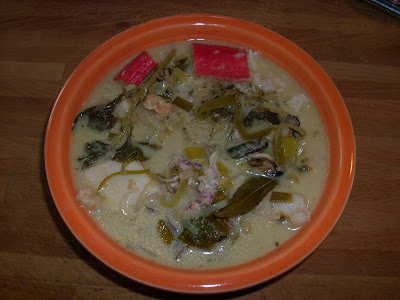
Now that you all have put in a hard one hour of work making a home made green curry paste, I can show you when it really pays off. I love to make a quick soup for lunch and you can't get much easier than this. I picked up some candy onions and leeks from my market, chopped them and sauteed them with a couple of tablespoons of the curry paste. Then I added:
2 cups of stock or water (I used chicken stock)
1 can of coconut milk
The protein of your choice (I used a 1 lb. bag of mixed seafood which included squid, octopus, clams, mussels, surimi and who knows what else) but chicken works great
1 tbsp. of fish sauce
Juice of 1 lime
A small chunk of jaggary (palm sugar) or brown sugar
That is all you need but because I still had some of the ingredients from the curry so I thought that I would add them.
Lime leaves
A slice of galangal
Thai basil
Cilantro
Curry leaves (just because I had some)
Simmer all of the ingredients together for a few minutes and add the protein at the end, just long enough to cook it through. This should only take you 10 or 15 minutes to prepare. Serve it over rice or rice noodles, or any other noodles for that matter.

There you go, quick easy and delicious.
(P.S. After I posted that putrid picture of the pasta with pesto, I thought I owed you a couple of decent ones of this soup. I'll have to pay more attention to the tips I get from Jerry mann.)




























